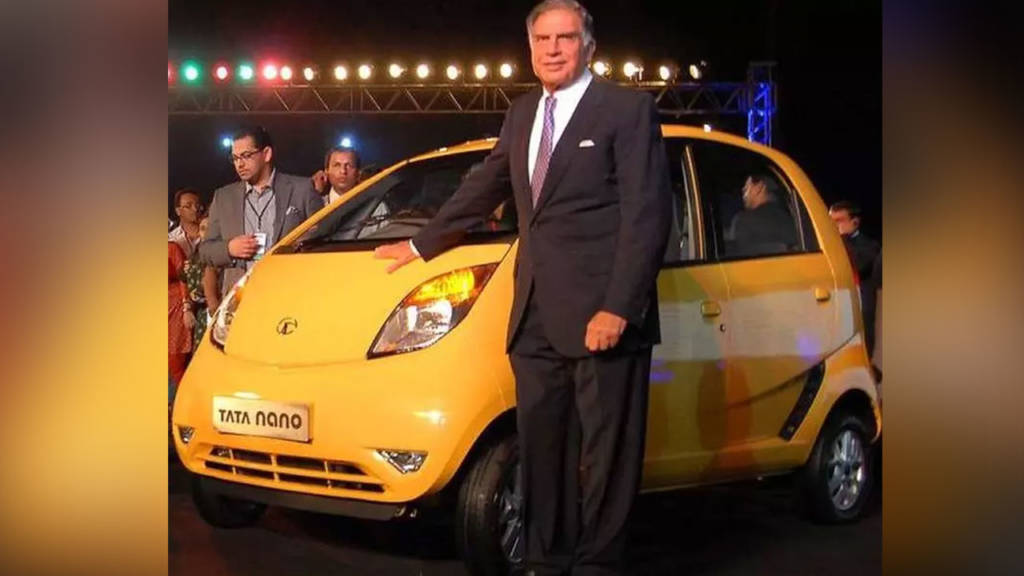It was in 2003 that the idea of the world’s cheapest car was conceived. This, after Ratan Tata, on a rainy day, saw a family of four travelling on a scooter, a common sight in India still. His mission was to make available to the emerging middle class back then, a simple, safe and cheap car. “The fact of unsafe travel was bothering me…What really motivated me…was constantly seeing Indian families riding on scooters, four or five on a scooter, maybe the child sandwiched between the mother and father…on slippery roads in the dark.” This was nothing more than a hazy dream, and many initially laughed it off. However, Ratan Tata gathered his top guns and embarked on a mission to achieve what he had espoused.
Initially, the engineers came up with something more than an autorickshaw but certainly less than a car. The first prototype is said to have had bars and grills as a major part of the body, while doors were substituted by plastic sheets to prevent the rains from coming in. Tata was not convinced. Ravi Kant, who spearheaded Tata’s acquisition of Jaguar Land Rover, at the time had said, “We didn’t want an apology for a car. We were conscious of the fact that whether it was a $2,500 car or not, it ought not to have looked like a $2,500 car.” Finally, after brainstorming all possibilities, a compact and seemingly sophisticated car was brought out. It shook the automobile industry, more so psychologically. Tata’s competitors were left scratching their hands the moment when Ratan Tata, a tall man himself, effortlessly got of his dream car at an Auto Show in New Delhi for the first time. And hence Tata Nano was revealed to the world.
Nano’s journey from conception to manufacturing has been a tumultuous one. Originally supposed to be manufactured at a grand facility in Singur, West Bengal, Nano will also be remembered as the car which caused the fall of the three-decade-long Communist rule in Bengal. Mamata Banerjee galvanized public opinion against this ‘invasion’ of farm land and built her political career in Bengal out of it. Ultimately, the Tata’s withdrew their plans of production in Singur. Spontaneously, Ratan Tata is said to have received an SMS which read, “Welcome to Gujarat.”
Then the Chief Minister of Gujarat, PM Modi is said to have made all arrangements for a manufacturing facility in Sanand. Six years after that SMS, the plant employed some 10,000 people, helping per capita income in Gujarat triple since Modi took office in 2001.
Finally, in 2009, the much-anticipated car was launched in two variants: a basic model priced at Rs.1,12,735 and the luxury version costing Rs.1,70,335. Indians, and the world, were in awe. In American dollars, the car costed a mere $2500. In 2010, the Tata’s were able to sell 9000 units of their unique car. In a year’s span, however, Nano had lost its steam, selling a meagre 500 units in 2011. The sales haven’t quite recovered, but have rather spiralled into a disaster ever since.
The primary reason for the fall in the Nano’s sale within a year of it hitting the markets can be attributed to security concerns. There were multiple incidents of the car catching fire for no specific reason. Secondly, the Nano wore out too soon. It didn’t give its owners the feeling that they were driving a car, and with time it rather felt more like an autorickshaw. For long journeys, Nano was no from the word go.
Nano after a point of time also began to be an identity problem for its owners. Indians’ grew complexes for owning a Nano, which was an indicator of one’s inability to buy some other car, bereft of the tag ‘world’s cheapest car’. The messaging, after an initial bump, began to work to the disadvantage of Nano. Also, the spending capacity of Indians’ increased tremendously over the same period of time. Instead of buying an odd 1.5 lakh Nano, the average Indian would think of waiting for a few months, getting hold of another 1.5 lakhs and ultimately buying, perhaps, a Maruti Suzuki Alto. All said and done, Indians love Maruti Sukuki. The “Ek he baar lena hai, Achi wali lenge” thinking trumped the impact of Nano over a period of time.
As a result of which, once the world’s cheapest car, is today at the verge of extinction.
Tata Nano produced zero units in 2019 and sold only one. According to a regulatory filing by the company, Tata Motors produced 82 units and sold 88 units in December 2018. Similarly, in November 2019 there was zero production and sales of the entry-level model, whereas in the year-ago period it produced 66 units and sold 77 units. Tata Motors has further admitted that in its current form the Nano will not meet the new safety regulations and BS-VI emission norms. Cyrus Mistry, former chairman of Tata Group remarked that while conceiving the idea of Nano, the prospect of it yielding profits was not given much attention and that due to Ratan Tata, it became more of an emotional issue for the company to bid farewell to the car despite it not finding any traction in the automobile market.
Nano currently is produced only on demand, however, it is now almost assured that production will be stopped for once and for all.
